-
REFLECTION01-01-2018
Health advocacy in nursing: contribution to the reorientation of the Brazilian healthcare model
Revista Brasileira de Enfermagem. 2018;71:700-703
Abstract
REFLECTIONHealth advocacy in nursing: contribution to the reorientation of the Brazilian healthcare model
Revista Brasileira de Enfermagem. 2018;71:700-703
DOI 10.1590/0034-7167-2017-0615
Views0See moreABSTRACT
Inequalities are the result of the different positions held by individuals in different social spaces, and are related to the distribution of power and property. Health advocacy is a strategy to reduce such inequalities, especially those considered unfair and unnecessary, aiming to fully promote the right to health. This study aims to discuss the contribution of nursing in the field of health advocacy, which includes the right of everyone to a healthy life as one of the strategies for the reorientation of the Brazilian healthcare model.
-
REVIEW01-01-2018
Coping strategies for domestic violence against pregnant female adolescents: integrative review
Revista Brasileira de Enfermagem. 2018;71:693-699
Abstract
REVIEWCoping strategies for domestic violence against pregnant female adolescents: integrative review
Revista Brasileira de Enfermagem. 2018;71:693-699
DOI 10.1590/0034-7167-2017-0682
Views0See moreABSTRACT
Objective:
To investigate and analyze in the scientific literature coping strategies for domestic violence against pregnant female adolescents.
Method:
This is an integrative literature review, conducted from July to August 2017 on LILACS, SciELO and PubMed, using the descriptors and the MeSH terms: confrontation, violence, adolescent, pregnant women, prenatal care.
Result:
The sample comprised 9 articles that were organized and characterized according to year, country of study and coping strategy used. The main forms of coping involved the active search for cases and the primary care approach with all family members.
Conclusion:
Individualized prenatal care, the change in professional training and networking activities were pointed out as important components of the strategies for coping with violence against pregnant adolescents.

-
REVIEW01-01-2018
People living on the street from the health point of view
Revista Brasileira de Enfermagem. 2018;71:684-692
Abstract
REVIEWPeople living on the street from the health point of view
Revista Brasileira de Enfermagem. 2018;71:684-692
DOI 10.1590/0034-7167-2017-0547
Views0See moreABSTRACT
Objective:
To know the Brazilian scientific production of the last ten years (2007 to 2016) about people who experience street situations under the health gaze.
Method:
Integrative literature review using the descriptors: street people, health policy and public health. We analyzed 21 articles available in the Virtual Health Library.
Results:
Four categories of analysis emerged. There was an increase in the frequency of published work on the subject, showing that the experience of living on the street makes people vulnerable to various diseases and health problems and, in addition, increases the difficulties of access to health services.
Conclusion:
There was an increase in the discussion of this topic due to the increase in the number of published studies. Despite the existence of public health policies directed to this social group, much still needs to be done to guarantee the health of this population.
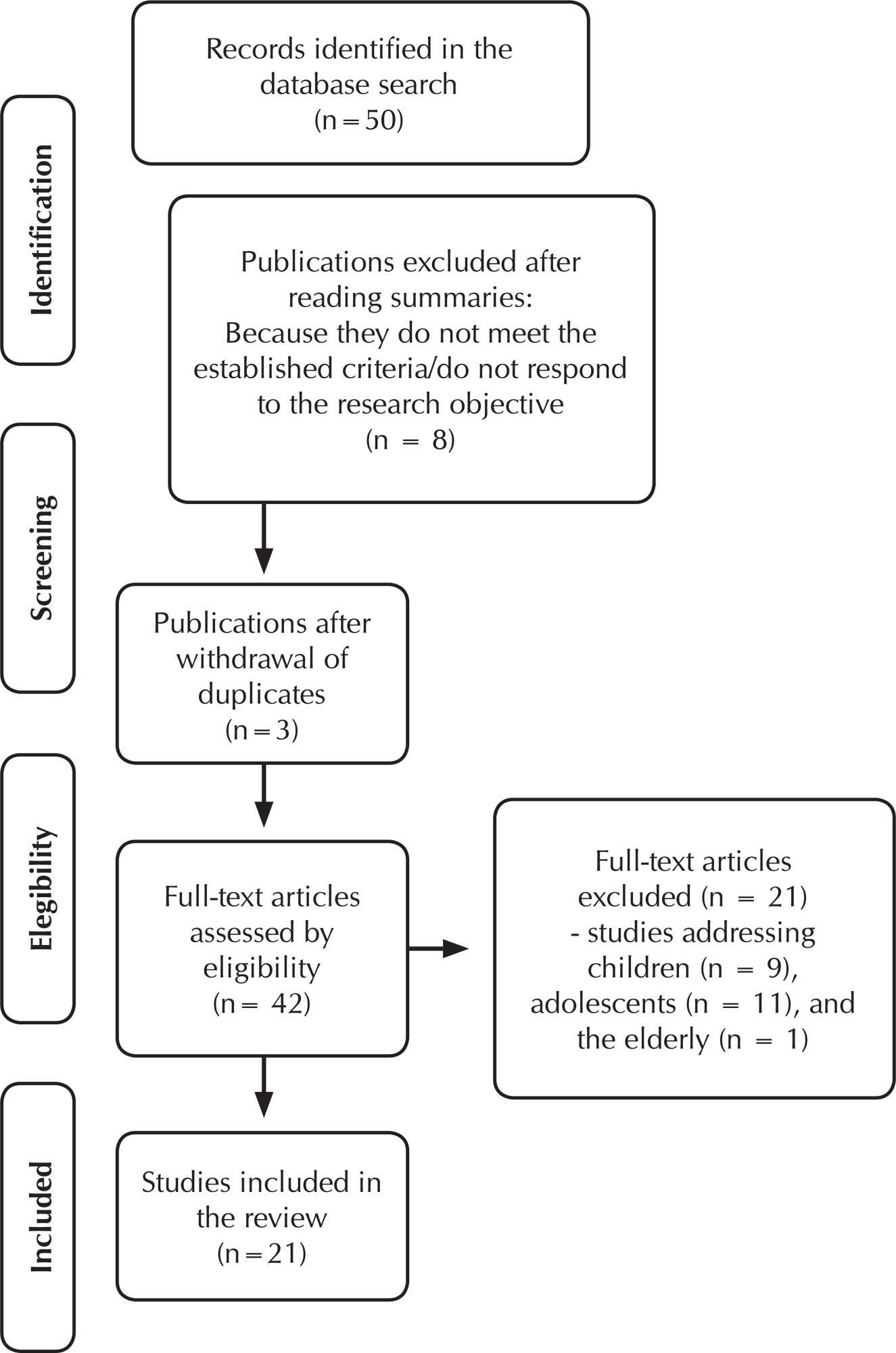
-
RESEARCH01-01-2018
Epidemiological profile of maternal mortality
Revista Brasileira de Enfermagem. 2018;71:677-683
Abstract
RESEARCHEpidemiological profile of maternal mortality
Revista Brasileira de Enfermagem. 2018;71:677-683
DOI 10.1590/0034-7167-2017-0624
Views0See moreABSTRACT
Objective:
To know the epidemiological profile of maternal mortality in Juiz de Fora, a city in the state of Minas Gerais. Data collection was carried out from April to December 2016.
Method:
Summary of a confidential investigation of maternal mortality on deaths occurred from January 1st, 2005 to December 31, 2015.
Results:
Eighty-five deaths of women residing in Juiz de Fora were identified and analyzed. The age group was between 20 and 36 years. The women carried out prenatal care (74.1%) with less than six visits (34.0%). Cesarean section was conducted in 38.8% of the childbirths and the obstetric treatment was considered appropriate (32.9%). The first cause of maternal death was hypovolemic shock 12 (14.10%), followed by uterine hypotony 6 (7.0%).
Conclusion:
Cesarean section rates are high and prenatal adherence is lower than that expected, which could justify the number of deaths in the period studied.
-
RESEARCH01-01-2018
Permanent education in the vaccination room: what is the reality?
Revista Brasileira de Enfermagem. 2018;71:668-676
Abstract
RESEARCHPermanent education in the vaccination room: what is the reality?
Revista Brasileira de Enfermagem. 2018;71:668-676
DOI 10.1590/0034-7167-2017-0560
Views0See moreABSTRACT
Objective:
To understand, from the perspective of the professional, the Permanent Education (PE) in the vaccination room in its real context.
Method:
Multiple holistic-qualitative case studies, based on Maffesoli’s Interpretive Sociology with 56 participants from four microregions of the Western Extended Region of Minas Gerais State.
Results:
They present PE as infrequent and insufficient. They denote that the practical-theoretical experience with vaccine contributes to the work; the search for knowledge, starting from the professional itself; and the professional training fails to perform in the vaccination room.
Final considerations:
The notions of PE are linked to the daily needs of individuals and services, with indication of being interactive, periodic, in specific and non-global issues for better assimilation. Obstacles to the non-implementation of PEH are realized by the workload associated with insufficient human resources, the distance of the nurses from the vaccination room and the lack of support from the higher levels.
-
RESEARCH01-01-2018
Work and Leprosy: women in their pains, struggles and toils
Revista Brasileira de Enfermagem. 2018;71:660-667
Abstract
RESEARCHWork and Leprosy: women in their pains, struggles and toils
Revista Brasileira de Enfermagem. 2018;71:660-667
DOI 10.1590/0034-7167-2017-0598
Views0See moreABSTRACT
Objective:
To analyze the interference of leprosy in women’s life regarding work and daily life activities.
Method:
Exploratory qualitative study developed from semi-structured interviews and with the use of field diaries. The strategy of the organization of data was a thematic analysis of content and referential of the work process in health and gender.
Results:
The themes presented are: “The leprosy pains”, “Changes with the disease and adaptation at work and activities” and “Being a woman with leprosy”. On them, we present the aspects that changed in women’s life from the leprosy, especially regarding work and daily activities. Beyond physical limitation, there are impacts on social relations and above all on formal work, there may even be dismission.
Final considerations:
In women affected by leprosy, work and daily activities are directly affected; this deepens the social difficulties and requires attention of health professionals.
-
RESEARCH01-01-2018
Social networks of patients with chronic skin lesions: nursing care
Revista Brasileira de Enfermagem. 2018;71:652-659
Abstract
RESEARCHSocial networks of patients with chronic skin lesions: nursing care
Revista Brasileira de Enfermagem. 2018;71:652-659
DOI 10.1590/0034-7167-2017-0581
Views0See moreABSTRACT
Objective:
To describe the social networks of patients with chronic skin damages.
Method:
A qualitative study conducted through semi-structured interviews with nine subjects with chronic skin lesions from June 2016 to March 2017; we used the theoretical-methodological framework of Lia Sanicola’s Social Network.
Results:
The analysis of the relational maps revealed that the primary network was formed mainly by relatives and neighbors; its characteristics, such as: reduced size, low density and few exchanges/relationships, configures fragility in these links. The secondary network was essentially described by health services, and the nurse was cited as a linker in the therapeutic process.
Final considerations:
Faced with the fragility of the links and social isolation, the primary health care professionals are fundamental foundations for the construction of networks of social support and care for patients with chronic skin lesions.

-
RESEARCH01-01-2018
Factors associated with delay in seeking care by tuberculosis patients
Revista Brasileira de Enfermagem. 2018;71:646-651
Abstract
RESEARCHFactors associated with delay in seeking care by tuberculosis patients
Revista Brasileira de Enfermagem. 2018;71:646-651
DOI 10.1590/0034-7167-2016-0680
Views0See moreABSTRACT
Objective:
To identify social, clinical and behavioral factors of tuberculosis patients that are associated with delay in the search for primary health care.
Method:
This is a cross-sectional, quantitative study conducted with 56 people on treatment for pulmonary tuberculosis in the city of Natal, in the state of Rio Grande do Norte, Brazil. The data were collected through a structured instrument. The Chi-square and Fisher tests were applied to test the association between independent and dependent variables (search time). A value of p <0.05 was set as statistically significant.
Results:
No social or clinical variables were statistically associated with patient delays in the search for primary health care. Among the behavioral variables, self-medication and the first health service sought had a statistically significant association with the time for seeking care (p = 0.020, and p = 0.033, respectively).
Conclusion:
Self-medication contributes to the delay in the search for primary health care by tuberculosis patients.
-
REVIEW06-17-2020
The role of the nurse in caring for the critical patient with sepsis
Revista Brasileira de Enfermagem. 2020;73(4):e20190031
Abstract
REVIEWThe role of the nurse in caring for the critical patient with sepsis
Revista Brasileira de Enfermagem. 2020;73(4):e20190031
DOI 10.1590/0034-7167-2019-0031
Views0See moreABSTRACT
Objectives:
to know the nursing interventions in the identification, prevention and control of sepsis in critical patients.
Methods:
integrative review of the literature, with two parallel researches using different MesH terms, using the EBSCO database and Google Scholar. Nine studies were included in the sample.
Results:
nursing interventions are centered on the creation/implementation of protocols for the early recognition of sepsis, the training of teams to ensure a safe and effective approach and the adoption of measures for infection prevention and control as a way to prevent sepsis.
Final Considerations:
the evidence shows that nurses are fundamental in the early identification, control and prevention of sepsis, preventing disease progression and contributing to decreased morbidity and mortality.
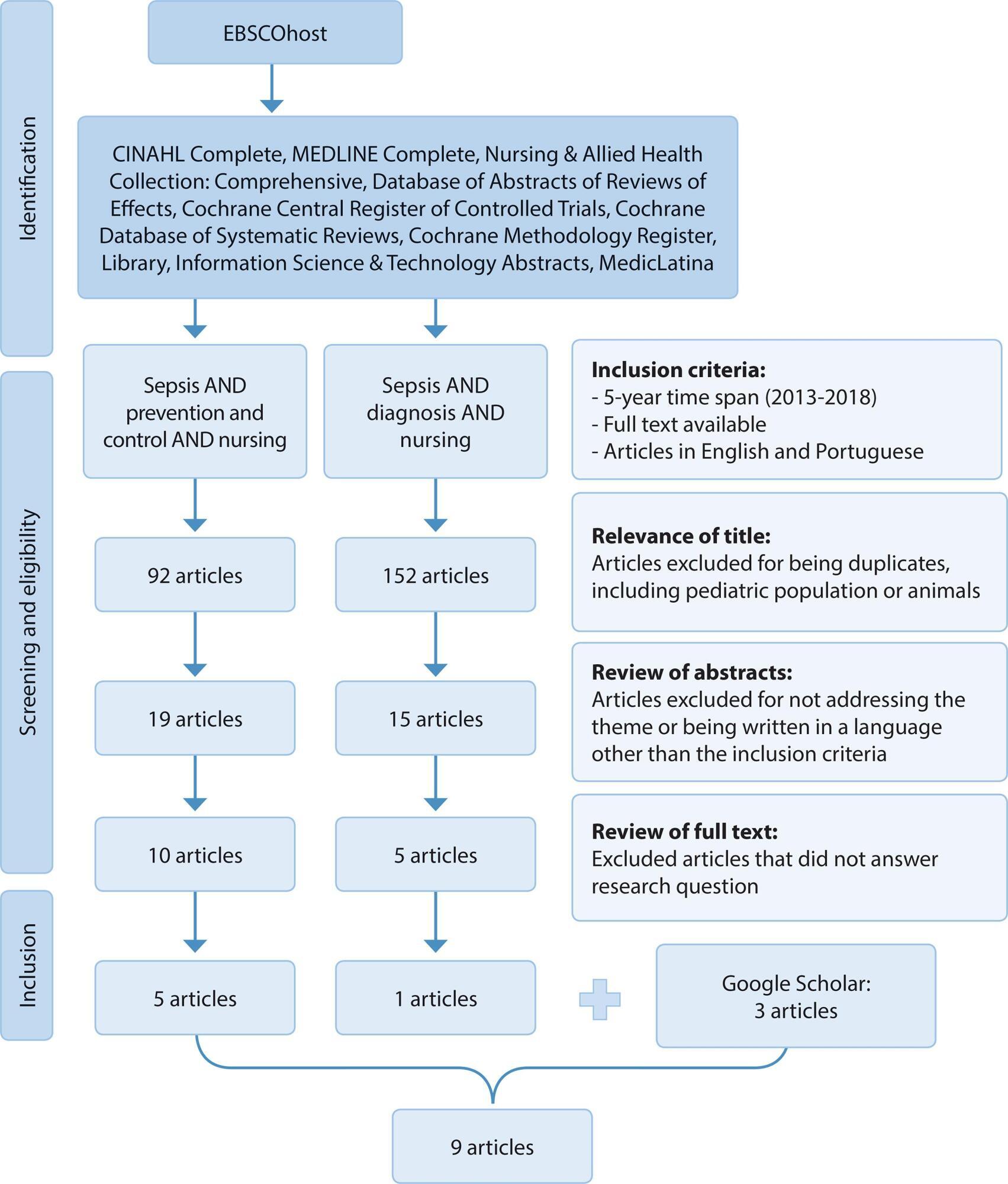
-
ORIGINAL ARTICLE02-10-2020
Common Mental Disorders and Contemporary Factors: 1982 Birth Cohort
Revista Brasileira de Enfermagem. 2020;73(1):e20180162
Abstract
ORIGINAL ARTICLECommon Mental Disorders and Contemporary Factors: 1982 Birth Cohort
Revista Brasileira de Enfermagem. 2020;73(1):e20180162
DOI 10.1590/0034-7167-2018-0162
Views0See moreABSTRACT
Objective:
To describe the association between common mental disorders and socio-demographic variables, smoking habits and stressful events among the 30-year-old members of a 1982 cohort.
Method:
Mental disorder was analyzed by the Self-Reporting Questionnaire (SRQ-20). Poisson regression was used to analyze the unadjusted and adjusted associations.
Results:
Low level of education and stressful events increased the prevalence of mental disorders for both genders. Lower income for women and unemployment for men also remained associated with CMD.
Conclusion:
It was possible to describe the association between contemporary factors and mental disorders in a young population, to which prevention and control measures, through public policies proposed to the areas of Primary Care, Mental Health and Education, can represent a better quality of life and health.
-
ORIGINAL ARTICLE09-21-2020
Prevalence of xerostomia in women during breast cancer chemotherapy
Revista Brasileira de Enfermagem. 2020;73:e20190785
Abstract
ORIGINAL ARTICLEPrevalence of xerostomia in women during breast cancer chemotherapy
Revista Brasileira de Enfermagem. 2020;73:e20190785
DOI 10.1590/0034-7167-2019-0785
Views0See moreABSTRACT
Objective:
To identify the prevalence of xerostomia in women undergoing chemotherapy for breast cancer.
Method:
Prospective cohort with 27 women who underwent up to 16 sessions of intravenous chemotherapy. Data collection was performed at the outpatient clinic of a university hospital in the city of São Paulo, where two forms were applied before the start of treatment and the Xerostomia Inventory before and after each chemotherapy session.
Results:
Complaints of dry mouth were present in 48.1% of women before chemotherapy, and they were approximately 28 times more likely to develop dry mouth during treatment. It was observed that the use of antiemetics contributed to the occurrence of xerostomia, and the anti-ulcerous were presented as a protective factor.
Conclusion:
The study identified both a high prevalence of xerostomia regardless of the chemotherapy used and the need to create protocols to improve the quality of life of these patients.
-
ORIGINAL ARTICLE12-13-2019
Hammock and nesting in preterm infants: randomized controlled trial
Revista Brasileira de Enfermagem. 2019;72:96-102
Abstract
ORIGINAL ARTICLEHammock and nesting in preterm infants: randomized controlled trial
Revista Brasileira de Enfermagem. 2019;72:96-102
DOI 10.1590/0034-7167-2018-0099
Views0See moreABSTRACT
Objective:
To compare the physiological variables and the sleep-wake pattern presented by preterm in nesting and hammock positions after diaper change.
Method:
This is a crossover randomized controlled trial. It was conducted with 20 preterm infants who, after diaper change, were placed in nests or hammocks. These preterm infants were evaluated for physiological variables (heart rate and oxygen saturation) and behavioral variables (sleep and wakefulness).
Results:
There was no statistically significant difference in the studied variables between nesting and hammock positions. However, regarding the categorical variable sleep, the comparison between the research phases for the hammock position showed differences between the baseline phase and the immediate recovery (p=0.00), baseline and late recovery (p=0.00), response and immediate recovery (p=0.00), response and late recovery (p=0.00).
Conclusion:
No differences were identified between the nest and the hammock; however, the use of the hammock favored the sleep of preterm infants compared to its non-use.
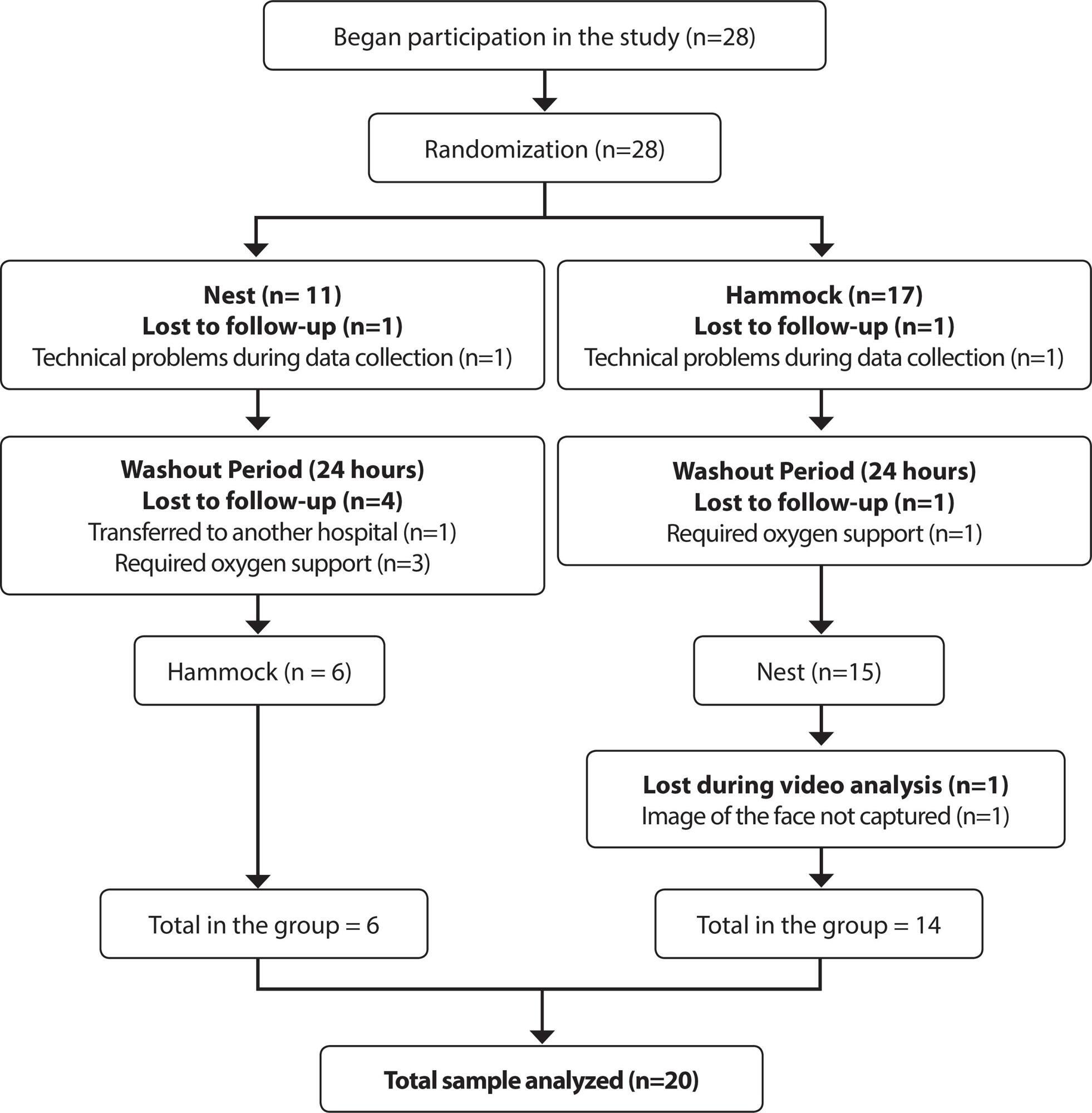
-
ORIGINAL ARTICLE05-15-2020
Configuration of power relations in physicians and nurses’ professional practices
Revista Brasileira de Enfermagem. 2020;73:e20180629
Abstract
ORIGINAL ARTICLEConfiguration of power relations in physicians and nurses’ professional practices
Revista Brasileira de Enfermagem. 2020;73:e20180629
DOI 10.1590/0034-7167-2018-0629
Views0See moreABSTRACT
Objective:
to analyze the configuration of power relations constituted in and by the knowledge and daily practices of physicians and nurses in an Intensive Care Unit (ICU).
Method:
qualitative study in which data were collected through interviews with physicians and nurses from an ICU of a hospital in Belo Horizonte, Minas Gerais. A semi-structured script was used. Data were analyzed through discourse analysis in a Foucaultian perspective.
Results:
three categories were developed – Professional Identity: self-recognition in the profession; Discipline: individualizing attitudes or collective need?; and Circularity of knowledge and power in the constitution of daily practices.
Final considerations:
the identity, discipline and circulation of power are connected in a continuous movement of subjectivation of the subject, which, in turn, uses discourse as a persuasion strategy to modify the position taken over in different situations thereby causing the circulation of power.
-
REVIEW03-30-2020
Internet influence on the biopsychosocial health of adolescents: an integratitive review
Revista Brasileira de Enfermagem. 2020;73(2):e20180766
Abstract
REVIEWInternet influence on the biopsychosocial health of adolescents: an integratitive review
Revista Brasileira de Enfermagem. 2020;73(2):e20180766
DOI 10.1590/0034-7167-2018-0766
Views0See moreABSTRACT
Objectives:
To identify scientific evidence on the influence of internet use on adolescents’ biopsychosocial health.
Methods:
Integrative review, with database search, using the descriptors “internet”, “adolescent health” and “adolescent behavior”. After applying the inclusion and exclusion criteria, 16 articles were selected.
Results:
Knowledge convergence produced for three main themes was demonstrated: “Internet exposure time and possible damages to adolescent health”; “Internet, adolescent and cyberbullying”; and “Internet as a source of information for adolescent health”.
Final considerations:
The network involves an intricate network of interactions, providing varied behaviors and attitudes that reflect on adolescent health. Therefore, it is important to articulate nursing actions with the school community and the family, in order to carry out health education.
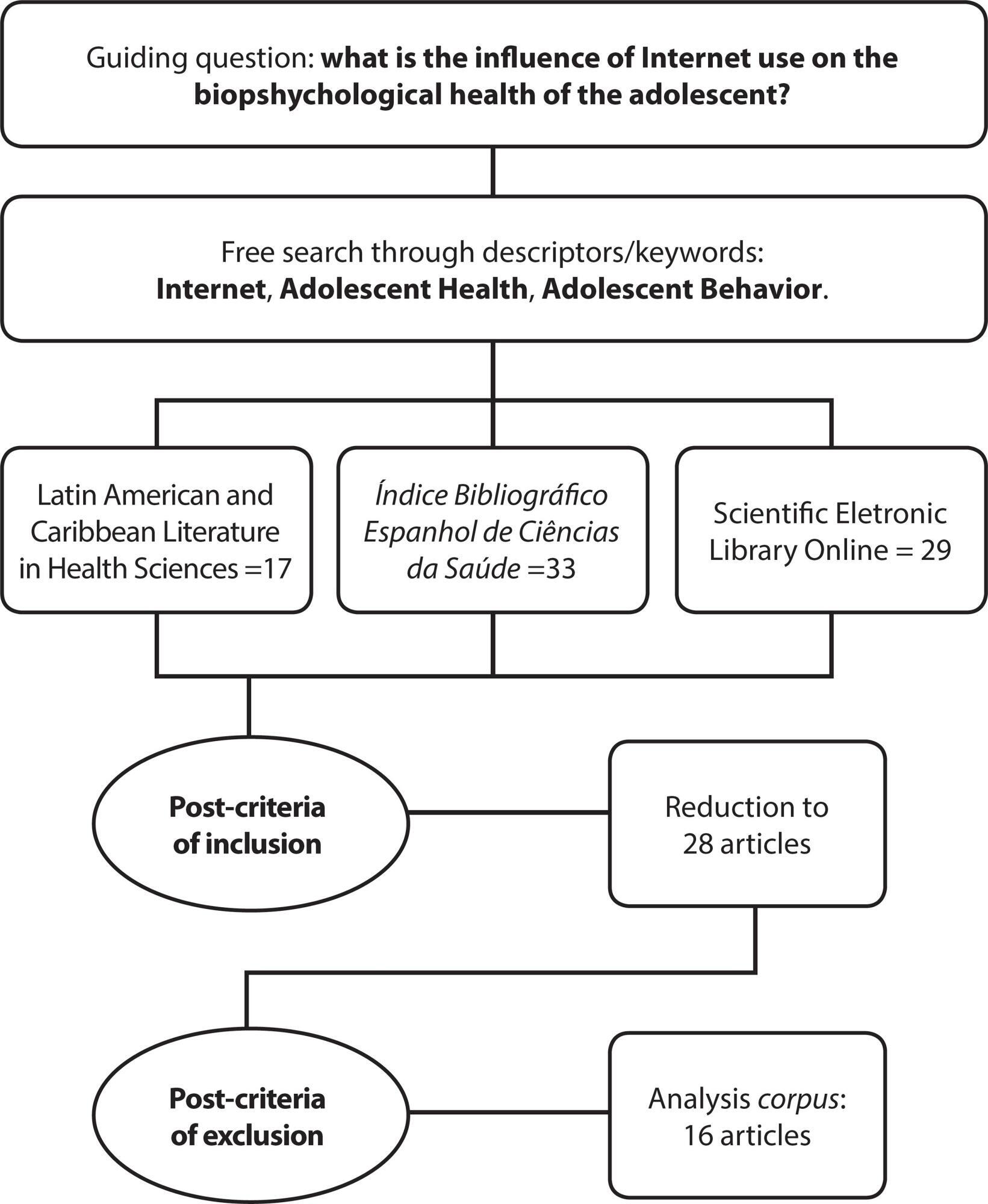
-
ORIGINAL ARTICLE02-17-2020
Analysis of records by nursing technicians and nurses in medical records
Revista Brasileira de Enfermagem. 2020;73(2):e20180542
Abstract
ORIGINAL ARTICLEAnalysis of records by nursing technicians and nurses in medical records
Revista Brasileira de Enfermagem. 2020;73(2):e20180542
DOI 10.1590/0034-7167-2018-0542
Views0See moreABSTRACT
Objectives:
to analyze the main non-conformities of the nursing records of a public hospital in Natal, Brazil.
Methods:
this is a descriptive, cross-sectional study, with a quantitative approach. This study was conducted in nursing departments of medical and surgical wards. The sample was composed of 120 medical records of inpatients between October and December 2016. The obtained data were tabulated and analyzed by simple statistics in absolute and relative frequency using the 2013 Microsoft Excel software. The Pareto Diagram was used to evaluate the non-conformities of the records.
Results:
the main problems in the nursing records were the absence of the professional category and the nursing council number, responsible for 41.8% of the non-conformities in the records of nursing technicians; for nurses’ records, the main non-conformities were the absence of time and the illegible handwriting, with 61.2%.
Conclusions:
the study showed that nursing professionals perform their records incompletely and often do not document the care provided.
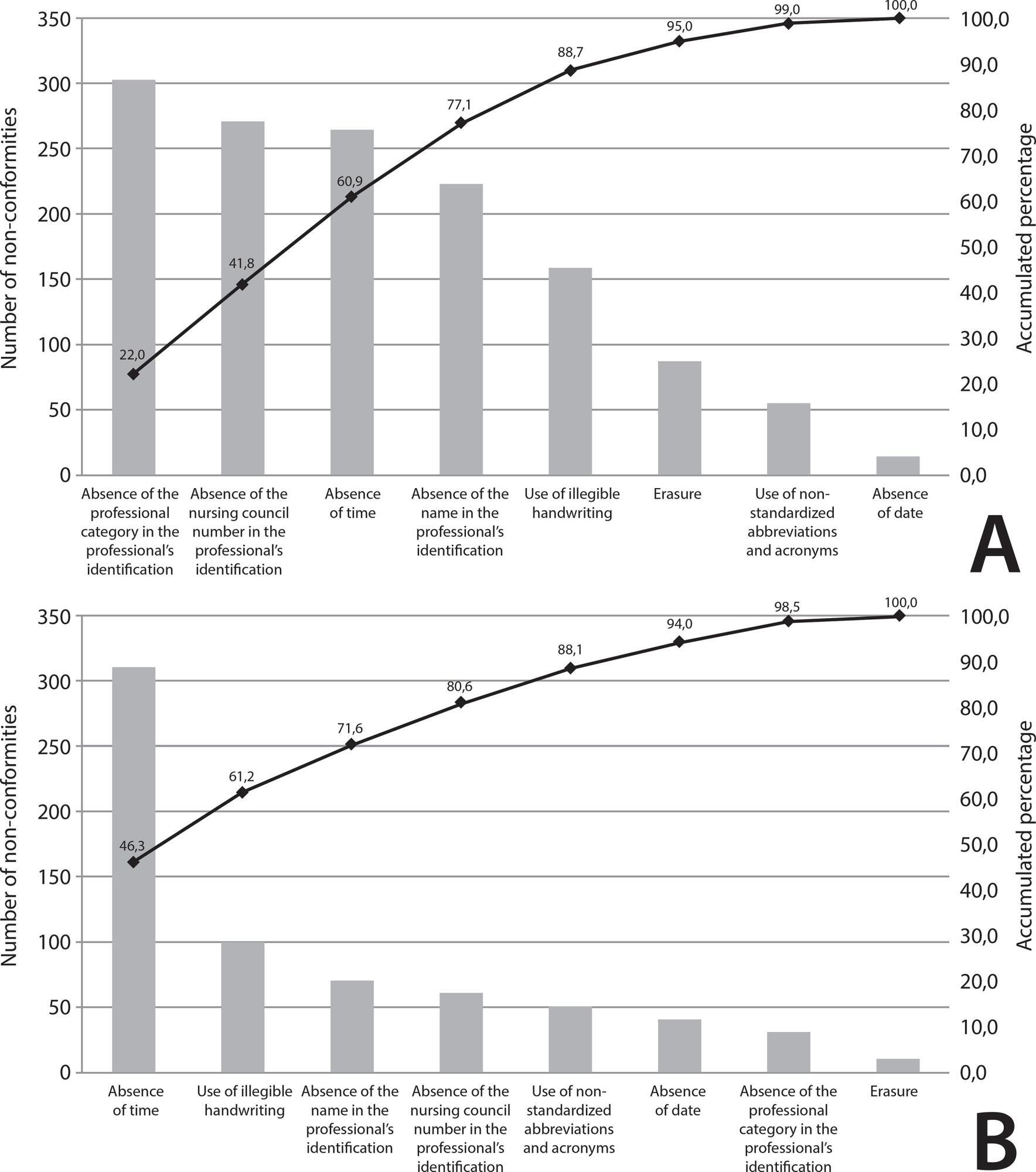
-
12-05-2019
Hospital care and urinary incontinence in the elderly
Revista Brasileira de Enfermagem. 2019;72:284-293
Abstract
Hospital care and urinary incontinence in the elderly
Revista Brasileira de Enfermagem. 2019;72:284-293
DOI 10.1590/0034-7167-2018-0273
Views0See moreABSTRACT
Objective:
to identify factors inherent in hospital care that favor urinary incontinence in the elderly.
Method:
an integrative review with Scopus, CINAHL and Pubmed searches. Includes original articles, no language restriction, published between 2008 and 2018. Rated level of recommendation and level of evidence were assessed using the Oxford Center for Evidence-Based Medicine classification. Exploited content through thematic analysis in light of the Donabedian model.
Results:
13 articles constituted the sample. There were factors such as the unjustified and indiscriminate use of devices such as the geriatric diaper; hospital structure adversely affecting the needs of the elderly; and deficit in screening, risk identification and underreporting of the problem favor urinary incontinence in the hospitalized elderly.
Conclusion:
modifiable factors related to hospital structures and care processes favor both the onset and worsening of urinary incontinence in the elderly.
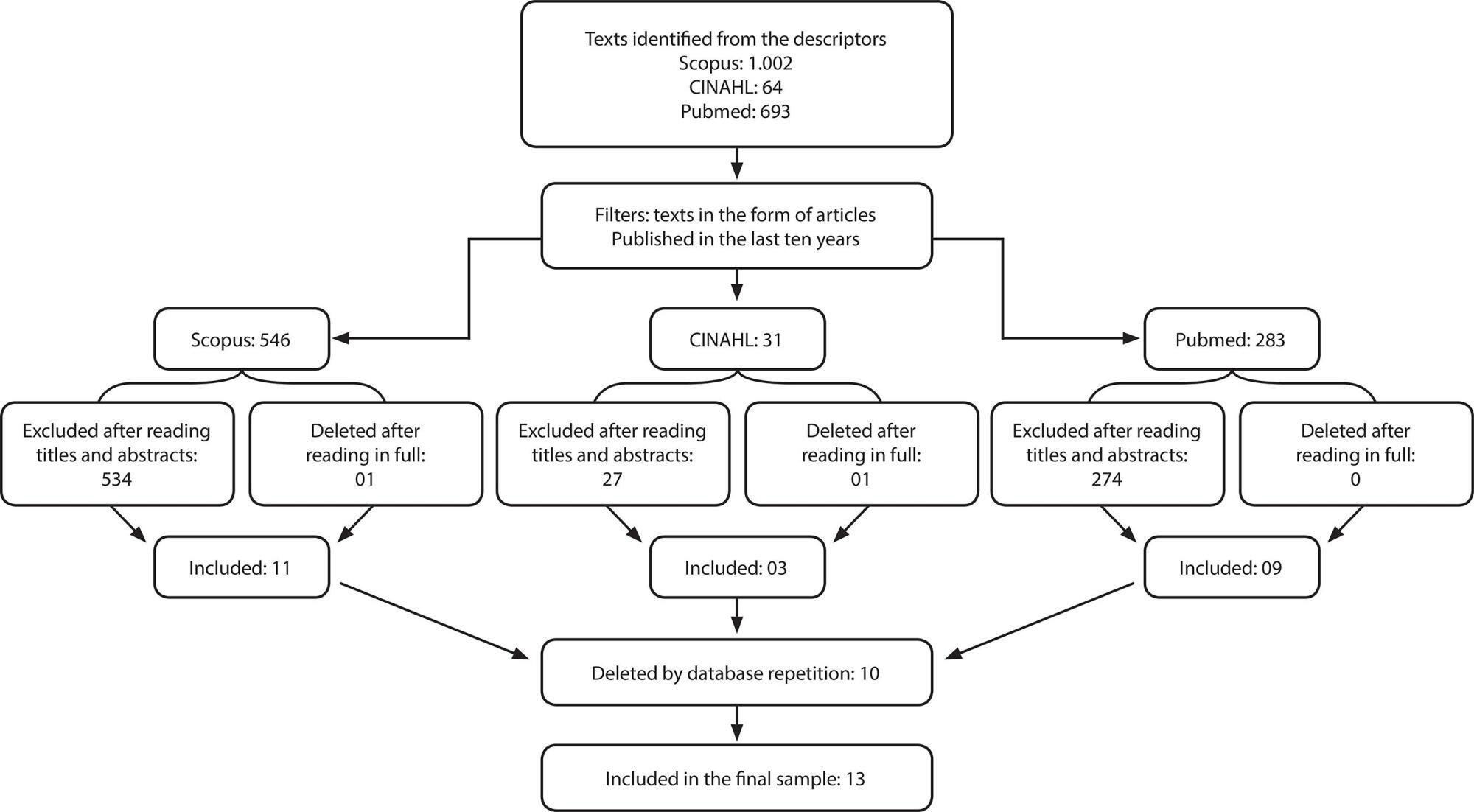
Search
Search in:
Nuvem de Tags
Enfermagem (930)Cuidados de Enfermagem (269)Atenção Primária à Saúde (239)Idoso (208)Educação em Enfermagem (151)Segurança do Paciente (150)Saúde Mental (145)Educação em Saúde (139)Estudos de Validação (131)Qualidade de Vida (104)Tecnologia Educacional (100)Promoção da Saúde (99)COVID-19 (91)Criança (91)Família (87)Enfermagem Pediátrica (86)Saúde do Trabalhador (86)Adolescente (85)Saúde Pública (82)Estudantes de Enfermagem (77)



